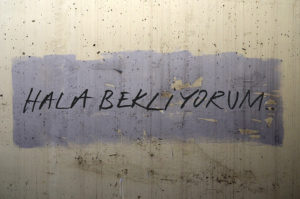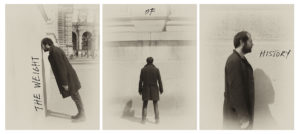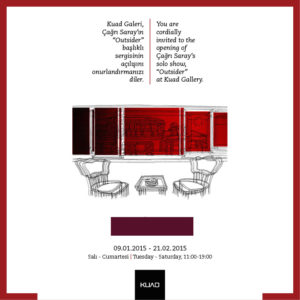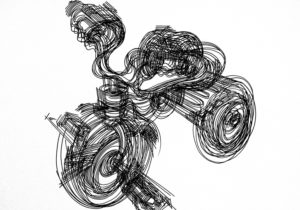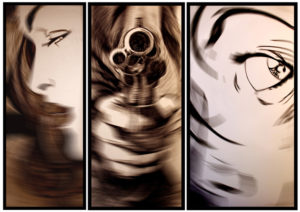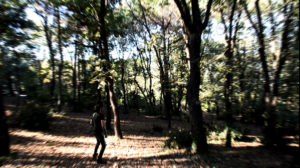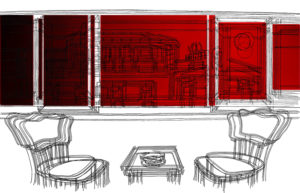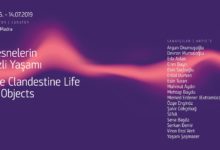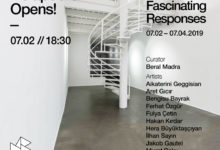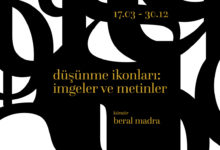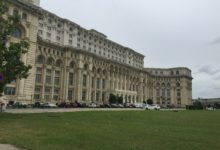OUTSIDER
ÇAĞRI SARAY SOLO EXHIBITION/KİŞİSEL SERGİSİ
9 January/Ocak – 21 February/Şubat 2015
It’s very important to understand that an artistic truth is a proposition about the sensible in the world. It’s a proposition about a new definition of what is our sensible relation to the world, which is a possibility of universality against the abstraction of finance and power.
Alain Badiou, Fifteen Theses on Contemporary Art
http://www.lacan.com//frameXXIII7.htm
The corpus of Çağrı Saray’s works presented in this exhibition entitled OUTSIDER consists of drawings, etchings, photography and video; all arranged as an installation related to Saray’s visual reflections on questions of identity, the artist’s personal history, the concept of home-space and urban environment with its socio-political connotations.
Hence, the title OUTSIDER is correlated to his position as an artist in the current coercive political, economic and cultural transformations that shake the local and global living circumstances rather than to the content and form of the works. The content and forms of works meticulously map the various properties, phases and moments of these objectionable circumstances.
Since his debut in the highly competitive art scene of Istanbul, Saray distinguished himself with peculiar drawings of illustrative bizarre narrations, ordinary living scenes and common objects. Strong, determined lines multiply in these unusual drawings so that they create an animated image and refer to the flux and reflux of visual memory. The recent works in this exhibition are evidently derived from this basic concept and form but reverberate with multifarious properties and special effects.
First of all, these works, makes one reconsider the current competitive tension between hand drawing and computer drawing. This controversial condition is manifested most clearly. The works make perfect sense as we are now accustomed to computerized art making, but at the same time they imply the traditional sensibility towards what we expect from art making. The repetitive and complex mode of lines emphasizes the figurative imagery in the works, which is derived from the simple details of the real world and daily life. At the same time, the simplicity of these lines verifies that the idea is essentially born of simple line and the intention is to indicate the crucial individuality. In Saray’s output, line is applied both as a consequence of, and referred to as a vehicle for formal virtuosity and intense personal vision. Functional, simple, but also scenic and intricate drawings reside somewhere between reality and fantasy, form and non-form, creating a vibrant show rich in complexity and thought.
Saray’s work was previously shown in Kuad Gallery’s “OnLine” exhibition (November-December 2013), showcasing his works that focus on producing images with line. The realization of that exhibition was based on present-day motivations and intentions. It was witnessing the artist’s continuous commitment to the traditional and up-to-date techniques of line. The line was introduced as still the most fast and simple expression of idea and imagination, together with many possibilities of drawing a line with computer and video techniques that gives the artists motivation. It was a deliberate choice to name these current techniques as “works of line” and not “drawings” as the latter has a traditional-classical and Modernist-poetic meaning.
The political, social and cultural concepts and contents along with relational aesthetic in the images produced with various line techniques manifested in Saray’s drawings provide a refreshed gaze and perception for the viewer. Images in these works, simply made of lines, propose decipherable and intelligible metaphors. With their repetitive intricacy they convey a liberated form of seeing to the viewer. Saray presents a sparse – yet enchanting and subversive – alternative to the hegemony of forms of seeing strictly programmed by consumerism and media-oriented visual culture.
The same illusory perception of “hand made-computer-made” can be experienced with the 8 white on white reverse printed etchings entitled “Memory Spaces” (2014), which depict the transformation of urban scenery as if seen from a mirror – an inverted metaphor of what has been before and after the ruthless intervention of neo-capitalist interests of public and private sectors. Saray’s work evokes an extremely sensible approach on the contemporary concerns of private-space public-space oppositions. This sensibility is reflected in the artist’s method of creating a minimalist serene effect with white on white etchings.
The photography works show Saray’s inquisitive defiance more clearly. “The Weight of History”, a performance documentation, depicts a nervous personal isolation in front of the Louvre, in Paris, during his residency. The artist’s graceful anguish marks the reality that history matters and it has long-lasting, unexpected effects on social psychology unless it is not questioned and re-written. In a similar vein, “Feeling Like…” shows a bewildered person in an uncanny forest. Here, the uncanny ambiance, which upsets and disturbs the human engagement with the world around, is rendered as a blurred shot. The relation between the person and the forest-scape once again questions the ambiguous boundaries between self and environment.
In this corpus of Saray’s work, speculative perspectives on the decentered historical moment become visual anchors for the perceiving subject.
Beral Madra, December 2014
It’s very important to understand that an artistic truth is a proposition about the sensible in the world. It’s a proposition about a new definition of what is our sensible relation to the world, which is a possibility of universality against the abstraction of money and power.*
OUTSIDER (dışardaki) başlıklı sergide Çağrı Saray’ın sunduğu yapıt kümesi, onun kimlik soruları, kişisel tarihi, ev-mekan kavramı ve kentsel ortamın toplumsal-siyasal anlamları üstüne görsel düşüncelerini yansıtan desenleri, gravürleri, fotoğraf ve videolarının yerleştirmesini oluşturuyor.
Nitekim, OUTSIDER başlığı, yapıtların içeriği ve biçiminden çok, onun yerel ve küresel yaşam koşullarını sarsan zorlayıcı güncel siyasal, ekonomik ve kültürel dönüşümlerinde sanatçı olarak durumu/duruşu ile ilgilidir. Yapıtların içerik ve biçimleri bu karşı çıkılabilir koşulların çeşitli özellik, süreç ve anlarını titizlikle haritalandırıyor.
Saray, İstanbul’un oldukça rekabetli sanat ortamına çıkışından bugüne tuhaf anlatıları, sıradan yaşam sahnelerini ve gündelik nesneleri resimleyen özgül desenleriyle öne çıktı. Güçlü, kararlı çizgiler bu resimlerde çoğalıyor, öyle ki görsel belleğin akışı ve geriye akışına gönderme yapan hareketli imgeler oluşuyor. Bu sergideki güncel işleri de kuşkusuz onun bu temel kavram ve biçiminden kaynaklanıyor, ama çok yönlü değerler ve özel efektler yansıtıyor.
Öncelikle Saray’ın bu işleri elle çizmek ile bilgisayarla çizmek arasındaki güncel rekabet gerilimi düşündürüyor. Bu resimler bu rekabet durumunu açıkça vurguluyor. Bilgisayarlı çizimlere alıştığımız için de bu durum anlamlı geliyor, ancak aynı zamanda bizim sanat yapma eyleminden beklediğimiz o geleneksel duyarlılığı da tetikliyor. Bu karmaşık bir biçimde yinelenen çizgi modülleri yapıtlardaki gerçek ve gündelik yaşama ilişkin basit ayrıntıları içeren figüratif imgeleri vurgulayarak ortaya çıkarıyor.
Aynı zamanda, çizgilerin sadeliği düşüncenin temelde önce tek bir çizgiden doğduğunu ve amacın ödünsüz bir bireysellik olduğunu kanıtlıyor. Saray’ın yapıt birikiminde çizgi hem biçimsel bir ustalığın sonucu olarak uygulanıyor hem de yoğun bir kişisel öngörünün aracı olarak kullanılıyor. İşlevsel, yalın, ama manzaralı ve girift resimler gerçek ve fantezi, biçim ve biçim-sizlik arasında bir yerde, bağlamlılık ve düşünce dolu canlı bir gösteri yaratıyorlar.
Saray’ın önceki işleri daha önce Kuad Galeri’de çizgi ile yapılmış imgelere odaklanan “OnLine” sergisinde gösterilmişti (Kasım-Aralık 2013). O serginin yapılmasına günümüzün motivasyonları ve amaçları neden olmuştu. Sanatçıların çizginin geleneksel ve güncel teknikleri ile süregelen ilişkisine tanık olunuyordu. Çizginin bilgisayar ve videonun çeşitli uygulama olanakları ile birlikte düşünce ve düşgücünün hala en hızlı ve yalın ifadesi olarak sanatçıya motivasyon verdiği savunuluyordu.
Yeni çizgi teknikleriyle gerçekleştirilen bu resimlere desenin geleneksel-klasik ve Modernist şiirsel bir anlam taşıdığını varsayarsak özellikle desen dememek, çizgi ile yapılmış işler demek daha doğru bir seçimdir.
Saray’ın ilişkisel estetik yöntemleri yanında siyasal, toplumsal ve kültürel kavram ve içerikler ve çeşitli çizgi teknikleriyle üretilmiş imgeleri izleyici için taze bir bakış ve algılama sunuyor. Yalın çizgilerle oluşturulan bu imgeler çözümlenebilir ve anlaşılabilir metaforlar öneriyor; çizgi yinelemesinin oluşturduğu oyun izleyicinin bakışını özgürleştiriyor; sade çizgilerle üretilen imgeler çözülebilirlik ve anlaşılabilirlik öneriyor; yinelemeyle oluşan bilmecemsi görüntü bağımsız bir görüşü çağırıyor. Saray, tüketim ve medya güdümünde programlanan görsel kültürün görme biçimleri egemenliğine karşı yalın –ama çekici ve muhalif – seçenekler sunuyor.
“Elle yapılmış-bilgisayarla yapılmış” yanılsaması “Bellek Mekanları (2014) başlıklı 8 adet beyaz üstüne beyaz ters basılmış gravürlerde de deneyimleniyor. Bu gravürler resmi ve özel sektörün Neo-kapitalist çıkarlarıyla acımasızca müdahale ettiği kent manzaralarının dönüşümünü -daha önce nasıldı, sonra nasıl olduğunun ters yüz edilmiş metaforu olarak tıpkı bir aynada görür gibi betimliyor. Saray’ın bu işleri de özel-alan kamusal-alan karşıtlığı üstüne özel bir güncel duyarlılık geliştirmeyi öneriyor. Bu beyaz üstüne beyaz gravürlerde bu duyarlılık minimalist ve soğukkanlı bir yaklaşımla yansıtılıyor.
Fotoğraf işleri de Saray’ın sorgulayıcı başkaldırısını açıkça gösteriyor. Bir performans belgelemesi olan “Tarihin Ağırlığı”, onun Paris’teki konuk sanatçı programı sırasında Louvre önünde tedirgin yalıtılmışlığını betimliyor. Sanatçının zarifçe yansıttığı sıkıntısı tarihin önemli olduğunun ve eğer sorgulanmaz ve yeniden yazılmazsa toplumsal psikoloji üstünde uzun süreli ve beklenmedik etkiler yaptığı gerçeğini işaret ediyor. “Gibi Hissetmek…” de benzer bir iz sürüyor ve tekinsiz bir ormanda telaşlı bir insanı gösteriyor. Bu insanın çevresindeki dünyayla ilişkisini sarsan ve rahatsız eden bu tekinsiz ortam bulanıklaştırılmış bir çekimle yansıtılıyor. Bu kişi ile orman manzarası arasındaki ilişki bir kez daha insanın kendisi ve çevresi arasındaki ikilemli sınırları sorguluyor.
Algı ortamı açık insan için Saray’ın bu yapıt kümesindeki spekülatif perspektifler ve merkezsizleştirilen tarihsel an görsel dayanak noktaları oluşturuyor.
Beral Madra, Aralık 2014
*Alain Badiou, Fifteen Theses on Contemporary Art http://www.lacan.com//frameXXIII7.htm

